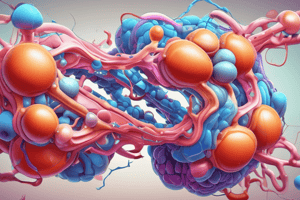Podcast
Questions and Answers
What is the formula for resolution as mentioned?
What is the formula for resolution as mentioned?
- resolution = n * sin q (correct)
- resolution = n / sin q
- resolution = n - sin q
- resolution = n + sin q
Which of the following factors influences resolution according to the content?
Which of the following factors influences resolution according to the content?
- Wavelength of light (correct)
- Magnification power
- Observer's distance
- Lens diameter
At which condition do we reach the limit of resolution when examining two points close together?
At which condition do we reach the limit of resolution when examining two points close together?
- When introduced in a phase contrast microscope
- When their distance is less than 0.61λ (correct)
- When they are observed under dark field microscopy
- When their distance exceeds the wavelength
What is the numerical aperture (NA) in air with n=1 at an angle of 60 degrees and wavelength of 390nm?
What is the numerical aperture (NA) in air with n=1 at an angle of 60 degrees and wavelength of 390nm?
Which microscope type is not primarily associated with modified light paths for improving resolution?
Which microscope type is not primarily associated with modified light paths for improving resolution?
What is the main advantage of fluorescence microscopy compared to traditional light microscopy?
What is the main advantage of fluorescence microscopy compared to traditional light microscopy?
What is one limitation of light microscopy that electron microscopy can overcome?
What is one limitation of light microscopy that electron microscopy can overcome?
Which technique allows for the isolation of specific cells from tissues?
Which technique allows for the isolation of specific cells from tissues?
What year was the term 'microscope' coined, and by whom?
What year was the term 'microscope' coined, and by whom?
Which of the following is NOT a characteristic of light microscopy?
Which of the following is NOT a characteristic of light microscopy?
What is the primary purpose of using fluorescent labels in microscopy?
What is the primary purpose of using fluorescent labels in microscopy?
Which of the following types of microscopy provides a three-dimensional view of the specimen?
Which of the following types of microscopy provides a three-dimensional view of the specimen?
What is the conventional resolution limit of a light microscope generally accepted to be?
What is the conventional resolution limit of a light microscope generally accepted to be?
Which fluorescent dye is specifically used to detect DNA?
Which fluorescent dye is specifically used to detect DNA?
What is a common application of GFP (green fluorescent protein)?
What is a common application of GFP (green fluorescent protein)?
Which of the following fluorescently labeled antibodies is NOT mentioned?
Which of the following fluorescently labeled antibodies is NOT mentioned?
What primarily differentiates CFP from GFP?
What primarily differentiates CFP from GFP?
Why are secondary antibodies used in fluorescent microscopy?
Why are secondary antibodies used in fluorescent microscopy?
When using multiple fluorescent probes, what is an important consideration?
When using multiple fluorescent probes, what is an important consideration?
What does the acronym DAPI stand for?
What does the acronym DAPI stand for?
Which of the following is NOT a fluorescent protein?
Which of the following is NOT a fluorescent protein?
What is a characteristic of primary cultures?
What is a characteristic of primary cultures?
Why do cells require a solid surface to grow and divide in vitro?
Why do cells require a solid surface to grow and divide in vitro?
What is replicative cell senescence primarily caused by?
What is replicative cell senescence primarily caused by?
Which cell line is commonly used for research and why?
Which cell line is commonly used for research and why?
What is one major application of hybridoma technology?
What is one major application of hybridoma technology?
What is the mechanism by which FACS isolates specific cell types from a tissue?
What is the mechanism by which FACS isolates specific cell types from a tissue?
What is the resolution capability of the Scanning Transmission Electron Holographic Microscope (STEHM)?
What is the resolution capability of the Scanning Transmission Electron Holographic Microscope (STEHM)?
Which microscopy technique is best suited for visualizing the surface of a sample?
Which microscopy technique is best suited for visualizing the surface of a sample?
How does light microscopy facilitate the observation of cellular activity?
How does light microscopy facilitate the observation of cellular activity?
What is one potential application of isolating specific cell types?
What is one potential application of isolating specific cell types?
Which of the following is NOT a method mentioned for isolating specific cell types from tissues?
Which of the following is NOT a method mentioned for isolating specific cell types from tissues?
What distinguishes the resolution capabilities of the STEHM from traditional electron microscopes?
What distinguishes the resolution capabilities of the STEHM from traditional electron microscopes?
What characteristic of actin filaments contributes to their structural role in cells?
What characteristic of actin filaments contributes to their structural role in cells?
Flashcards are hidden until you start studying
Study Notes
Introduction to Cell Biology
- Membrane structure, cell communication, cytoskeleton, and transport mechanisms are critical to understanding cell biology.
- Electrical properties of membranes facilitate membrane transport of small molecules.
- Intracellular compartments play significant roles in sorting proteins and vesicular traffic.
Visualization Techniques
- Light microscopes utilize various methods, including:
- Bright field microscopy
- Dark field microscopy
- Phase contrast microscopy
- Fluorescence microscopy employs fluorescent labels such as DAPI and FITC to visualize specific structures.
- Electron microscopy types include:
- Transmission Electron Microscopy (TEM)
- Scanning Electron Microscopy (SEM)
- Scanning Transmission Electron Holographic Microscopy (STEHM), capable of atomic-level resolution.
Isolation of Cells
- Techniques for isolating cells include:
- FACS (Fluorescence-Activated Cell Sorting) provides rapid sorting of cells based on fluorescent markers.
- Laser capture microdissection targets specific cells from tissues for analysis.
- Cell cultures are foundational in studying cellular behavior; common human cell line includes HeLa cells derived from Henrietta Lacks.
Historical Context
- 13th century: Spectacles invented for vision correction.
- Janssen's first compound microscope developed in 1590; Faber coined "microscope" in 1625.
- Zeiss and Abbe advanced commercial microscopes in the 19th century.
Microscopy Principles
- Conventional resolution limit of light microscopy is around 200 nm due to optical diffraction effects.
- Resolution depends on numerical aperture and light properties, allowing visibility of cellular structures.
Fluorescent Probes
- Fluorescent dyes (e.g., Hoechst, rhodamine) detect specific molecules.
- Genetic variants of fluorescent proteins (e.g., GFP) enable visualization of cellular processes and structures in living cells.
Advanced Microscopy
- Electron microscopy provides high-resolution imaging of intracellular organization and surfaces.
- STEHM offers unprecedented resolution, allowing observation of structures at atomic levels.
Applications of Cell Biology
- Studying the cell cycle, apoptosis, and signaling pathways is essential for understanding growth, development, and disease.
- Transgenic organisms and cell cultures enhance research capabilities in molecular biology and genetics.
Final Notes
- The ongoing evolution of microscopy techniques underlines the importance of advancing our understanding of cellular structures and functions.
- Understanding the isolation of specific cell types contributes significantly to research in fields like cancer biology and regenerative medicine.
Studying That Suits You
Use AI to generate personalized quizzes and flashcards to suit your learning preferences.




